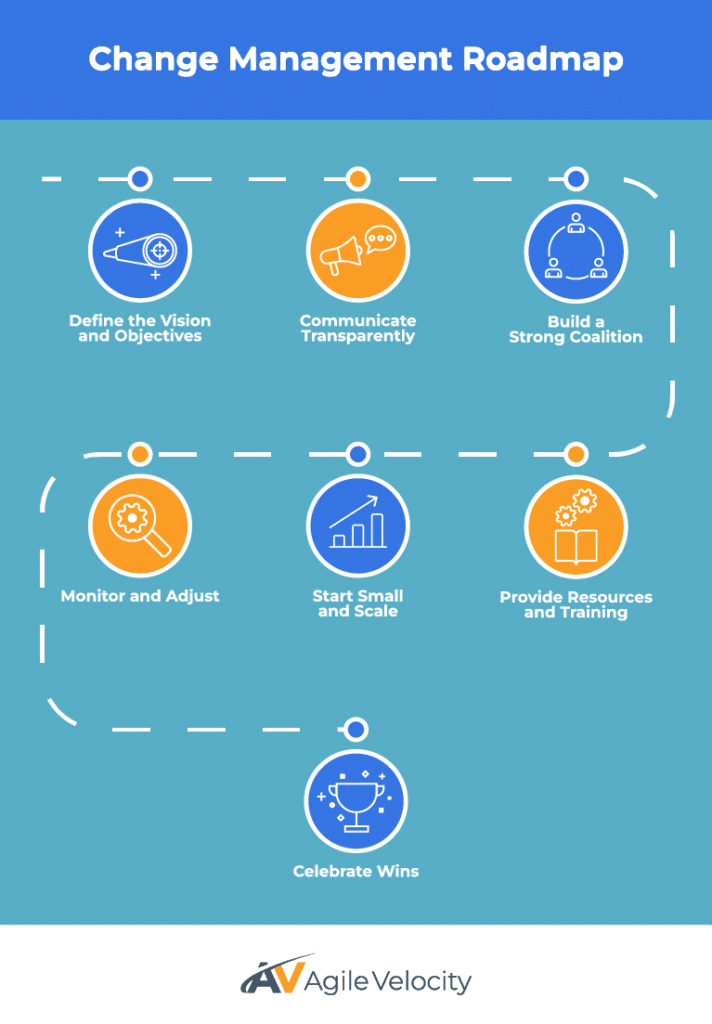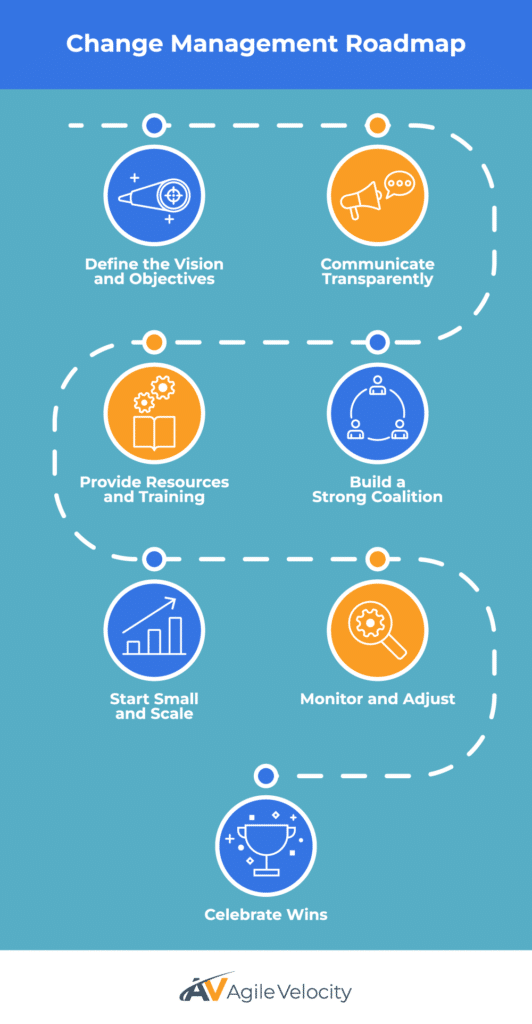Change is the essence of progress, yet managing it effectively remains one of the most overwhelming tasks for leaders. Whether it’s adopting new technologies, responding to market needs, or restructuring for efficiency, organizational change requires purposeful strategy and execution.
In this article, you will find the key aspects of managing organizational change, from challenges to solutions, offering actionable insights to turn transformation into lasting success.
Common Challenges in Organizational Change
Organizational change can be a complex and intimidating process due to a variety of factors. It is important to recognize and acknowledge them so they can be addressed effectively.
Below are some common challenges organizations face during change initiative:
1. Resistance to Change
Resistance to change is one of the most common and challenging obstacles organizations face during transformation efforts. It often stems from:
- Fear of the Unknown: Employees may feel uncertain about how the change will impact their roles, career paths, or job security. This fear can lead to hesitation or direct pushback.
- Comfort with the Status Quo: Long-standing processes, routines, and systems create a sense of familiarity and stability. Change disrupts this comfort zone, making employees reluctant to embrace it.
- Lack of Trust: If employees don’t trust leadership due to past experiences of mismanagement or unmet promises, they are less likely to support new initiatives.
Leaders must address these fears and concerns openly, offering reassurance, clear communication, and a compelling purpose for change.
2. Communication and Leadership Challenges
Effective communication and leadership support are critical for successful change management. Common issues include:
- Poor Communication: Ambiguity or lack of clear messaging can lead to confusion about the purpose, scope, and benefits of the change.
- Inconsistent Messaging: Mixed or conflicting messages from different leaders can undermine credibility and create confusion for the people in the organization.
- Lack of Vision: Without a clear and compelling vision, employees may struggle to understand why the change is necessary or how it aligns with organizational goals, or worse, what’s in it for them.
- Overburdened Leadership: Leaders who are stretched too thin may lack the time, energy, or focus to manage change initiatives effectively. Multi tasking has become the norm in the fast paced environment today, but that most often results in compromised focus.
Strong, consistent communication and active leadership involvement are essential to build trust, motivate employees, and maintain momentum.
Be the Leader Your Team Needs
3. Resource Constraints and Change Fatigue
Change initiatives require adequate resources and careful pacing to avoid overwhelming employees. Key challenges include:
- Limited Time and Budget: Change efforts often compete with day-to-day operations, and inadequate planning, funding or staffing can hinder progress.
- Skill Gaps: Employees may lack the necessary training or experience to adapt to new roles, systems, or processes.
- Change Fatigue: Organizations undergoing frequent changes risk disengagement and burnout among employees. Constant disruption can erode morale, productivity, and commitment.
To address these challenges, organizations should ensure adequate planning, allocate sufficient resources, and provide training and support for employees.
4. Cultural and Stakeholder Misalignment
Organizational culture and stakeholder alignment are critical to the success of any change initiative. Common obstacles include:
- Conflicting Values: If the change is misaligned with the organization’s existing culture or values, it may face resistance at all levels.
- Ingrained Behaviors: Long-standing habits and norms can be difficult to shift, even when the benefits of change are clear.
- Stakeholder Exclusion: Excluding key stakeholders—whether employees, leaders, or external partners—can lead to a lack of buy-in, collaboration, and support.
Building a culture that embraces change and actively involving stakeholders in the process are essential to overcoming these barriers.
5. Emotional and External Pressures
Change is not just a strategic or operational challenge—it also involves significant emotional and external factors. These include:
- Stress and Anxiety: Disruption to routines and uncertainty about the future can cause employees to feel overwhelmed and stressed.
- Fear of Failure: Employees may doubt their ability to adapt to new responsibilities or tools, leading to hesitation or resistance.
- Lack of Empowerment: Employees may not have the right decision-making power to succeed in the change initiative. Many organizations are still operating within a top down hierarchical structure that delay the local decision making resulting in waste.
Leaders must address these pressures with empathy, providing clear guidance, emotional support, and strategies for managing external constraints.
The Impact of Effective Change Management
Organizations need change management because it provides the structure, tools, and strategies necessary to navigate the complexities of transformation effectively. Change is inevitable to stay competitive. Without proper change management, organizations risk failed initiatives, wasted resources, and disengaged employees. Here’s why change management is essential:
1. Aligns Goals and Efforts
Change management provides clarity by aligning the organization’s vision with its transformation efforts. It ensures everyone understands the purpose and objectives of the change, fostering collaboration and preventing misaligned priorities.
2. Reduces Resistance and Encourages Adoption
Through transparent communication and active involvement of employees, change management addresses fears and resistance. It builds trust, aligns the change with organizational culture, and creates buy-in at all levels for smoother adoption.
3. Mitigates Risks and Prevents Failures
By proactively identifying potential obstacles and leveraging data-driven strategies, effective change management approaches reduce the risks of missteps. It enables informed decision-making and creates contingency plans, increasing the likelihood of success.
4. Maintains Productivity and Employee Morale
A structured approach minimizes disruption to daily operations. It optimizes resources, supports employees during transitions, and celebrates progress, ensuring teams stay motivated and productive throughout the change process.
5. Builds Agility and Delivers Measurable Results
Change management equips organizations to adapt quickly to future challenges, fostering resilience and innovation. By establishing clear metrics and accountability, it ensures that change initiatives deliver tangible, measurable benefits aligned with strategic goals.
Recognizing the need for change is the first step. Organizations that adapt proactively position themselves as industry leaders, while those that resist risk falling behind.
What Happens When You Delay Change

Delaying change often comes with steep consequences:
1. Missed Opportunities
In rapidly evolving markets, waiting to implement change can mean losing out on critical opportunities:
- Market Share Loss: Competitors who act quickly to adapt to customer needs or industry trends may capture significant market share.
- Innovation Gap: Organizations that delay adopting new technologies or practices may find themselves outpaced by more agile rivals.
- Stalled Growth: Postponing change limits the ability to enter new markets, launch new products, or diversify revenue streams.
Every delay gives competitors an advantage, making it harder to catch up later.
2. Employee Frustration
Persistent inefficiencies and a lack of direction take a toll on employees:
- Declining Morale: When employees encounter repetitive issues or feel that their efforts are wasted, their motivation decreases.
- Loss of Talent: Talented employees may leave for organizations that demonstrate a commitment to innovation and growth.
- Reduced Productivity: Unaddressed inefficiencies force employees to spend more time on redundant tasks, slowing down operations and innovation.
Addressing change early fosters a more engaged, satisfied, and productive workforce.
3. Increased Costs
The financial impact of delaying change can be significant:
- Escalating Issues: Small problems often grow into larger, more expensive ones over time, requiring greater resources to resolve.
- Operational Inefficiencies: Persisting with outdated systems or processes incurs ongoing costs that could be eliminated through modernization.
- Crisis Management: Delaying change often results in reactive, costly interventions rather than proactive, cost-effective solutions.
Acting swiftly and decisively minimizes these risks and ensures the organization stays ahead of the curve.
Key Roles in Successful Change Management
Effective change management is impossible without the right people. Key players include:
- Visionary Leaders: Leaders who can articulate the “why” behind the change and inspire trust.
- Change Champions: Influential employees who can advocate for the change and rally their peers.
- Skilled Coaches and Trainers: Individuals who can train and ensure the process is organized and on track.
- Engaged Teams: Employees who feel included and empowered to contribute to the change effort.
Investing in your people—through training, communication, and involvement—is critical to achieving success.
7 Steps for Effective Change Management
Managing change requires a structured approach. Here’s a roadmap:


Step 1: Define the Vision and Objectives
Start with a clear picture of what success looks like. What are the goals? How will this change benefit the organization and its people?
Step 2: Communicate Transparently
Keep everyone informed. Explain the “why,” address concerns, and ensure messages are consistent across the organization.
Step 3: Build a Strong Coalition
Identify leaders and influencers who can champion the change. Empower them to drive buy-in and support throughout the organization.
Step 4: Provide Resources and Training
Equip teams with the tools and knowledge they need to adapt. Offer workshops, training sessions, and open channels for questions.
Step 5: Start Small and Scale
Begin with pilot projects to test new approaches. Use the results to refine strategies and build confidence before a full rollout.
Step 6: Monitor and Adjust
Establish metrics to track progress and gather feedback. Be prepared to adapt as needed to address challenges or opportunities.
Step 7: Celebrate Wins
Recognize and celebrate milestones, both big and small. This keeps morale high and reinforces the value of the change effort.
Are You Ready?
Managing organizational change isn’t just a challenge—it’s an opportunity to evolve, grow, and excel. By addressing challenges head-on, recognizing the need for change, acting swiftly, involving the right people, and following a structured approach, leaders can transform resistance into resilience.
The rewards are well worth the effort: a more agile, efficient, and engaged organization ready to tackle the future with confidence.
The question is not whether your organization will face change, but how you will lead it. Are you ready?



